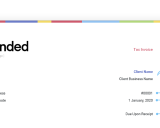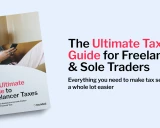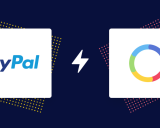
Toxic client behaviour: How to spot it and deal with it before it does harm
What do you do when a client is late paying invoices? Or calling you on the weekends? Or just generally being a jerk? Rebekah Lambert of Freelance Jungle weighs in with her advice on dealing with toxic client behaviour.
Article contents
− +
It may seem strange, but sometimes, it's a good thing when you come across red flags in your freelance work. Once you know how to spot them, red flags can keep you from taking on problematic clients that underpay you, are too demanding, or don’t respect your skills.
But sometimes, clients don't exhibit negative behaviour until contracts are already signed and work is underway. And without a roadmap, it can be near impossible to figure out how to deal with bad behaviour when it blindsides you late in the game.
Enter Rebekah Lambert, founder of Freelance Jungle. She's dedicated much of her career to bringing Australian freelancers together to share stories, advice, and support - including methods for dealing with harmful client behaviour.
As part of Hug a Freelancer month, we interviewed Rebekah to discuss some of the best ways to tackle some of these thorny issues. Here's what she had to say.

The 3 types of toxic client behaviour
At the start of our discussion, Rebekah divided bad client behaviour into three general categories. Chances are, you’ve encountered at least one of these along your sole trader journey.
Issues around paying invoices
Getting paid on time is perhaps the most common issue newer freelancers face.
It can happen with any type of client, from other solopreneurs to multinational corporations. It may happen most often at the start of new relationships, but it’s not unheard of for clients that have been good at paying their bills to drop the ball later down the track.
There are many reasons why a client may fail to pay an invoice. There may be a lot of red tape to get through to approve invoices, or your invoices might get lost in the shuffle of emails. And in the worst cases, clients may intentionally fail to pay invoices because they aren’t able to cover your fees.
Whatever the causes, this type of bad client behaviour can be seriously detrimental to your freelance business, especially when the unpaid invoice (or invoices) makes up a significant amount of your income.
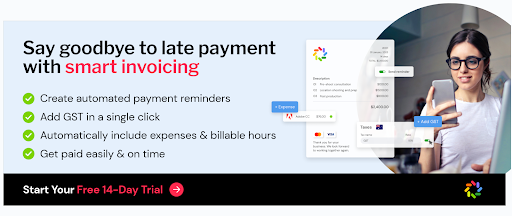
Disorganisation issues
To successfully run your freelance business, you likely have processes and systems in place to keep your work organised. Unfortunately, if your client doesn’t have a similar level of organisation, you could run into all sorts of problems.
A disorganised client may be unable to write coherent briefs or communicate their ideas to you effectively. They may constantly be asking you for information you’ve already provided, or come to you frantically when they need urgent help on something they never put on your radar.
It may be difficult to spot a disorganised client from the outset—they may put on their best behaviour at the start of the relationship, or slowly lose their commitment to using processes. But the result is the same: Their chaos is contagious, and can impact your ability to manage your own business.
Toxic behaviour issues
Though freelancers may not have to deal with aggressive bosses or navigate office politics, they still can encounter harmful behaviour in client relationships.
There are many different ways toxic behaviour can manifest in a client/freelancer relationship:
Abusive language or cruel tones of voice
Dismissiveness of the freelancer's actions or feelings
Gaslighting or lying to the freelancer
Failing to recognise hard work and a job well done
Gossipping about others involved in the work
Passing blame and throwing the freelancer under the bus
Harassing or bullying the freelancer in any way
Intentionally withholding payment for invalid reasons
Setting Boundaries: The Key to Combating Toxic Client Behaviour
Though there are many different forms of bad client behaviour, Rebekah explained that there’s one overarching issue that encompasses all of it: Boundaries.
If you can start any project with good, strong boundaries, you’ll face less hassles with everything else,” Rebekah said. “Because being a freelancer is kind of like being a dominatrix, a toddler-tamer, and a dog-trainer all in one. Without good boundaries in place, things can go off the rails quickly.
Unfortunately, there isn’t a handbook for setting boundaries with clients. It’s a skill that has to be learned, and can be tricky for freelancers that are just starting out.
Many freelancers start their journey because they are talented in a particular field, and want freedom in their working life. But as Rebekah pointed out, learning how to set boundaries with clients is an entirely different set of skills—one that takes practice to get right.
Rebekah shared some of her best tips for freelancers looking to improve their boundary-setting skills:
The earlier you set boundaries, the better
It is much easier to set boundaries early on in a working relationship, rather than trying to enforce them after things start going south.
Setting boundaries at the start is like laying the foundation for a strong, long-lasting relationship. You will be able to spell out exactly what you expect for all parties in the working relationship, and fall back on these if there are unforeseen issues later on.
For example, you can let clients know in your contract what your payment terms are—including expected payment dates and late-fee policies.
Now, when it comes time to reach out to the client, you’ll have a foundation for addressing non-payment, rather than bringing up your payment terms out of the blue, Rebekah said.
In addition to payment terms, you can also set boundaries at the start of the relationship by documenting:
Your hours/days of availability
Timelines for project turnaround
Communication policies
Feedback processes
Scope of work to be delivered
Learn how to stick to your boundaries
Once you’ve learned how to set boundaries with a client, the next challenge is learning to stick to them when they are tested.
A boundary only works if it’s actually enforced,” Rebekah said. “If you let clients cross your boundaries without consequences, you are essentially letting them know they can do whatever the heck they want.
For example, imagine you’ve made it clear your payment terms are 14 days after sending an invoice, but a client still hasn’t paid 28 days later. You haven’t called or emailed them because you don’t want to rock the boat. But now, the client believes that they can get away with not paying your invoices for over a week, and they’ll be likely to do it again.
You’ll need to have some practice overcoming the awkwardness and anxiety that comes with discussing payment with a client. It’s important to be firm and clear and keep your emotions out of the best you can.
It can be helpful to have a few phrases in your back pocket, and practice saying them even if all your clients are behaving at the moment. Here are some examples.
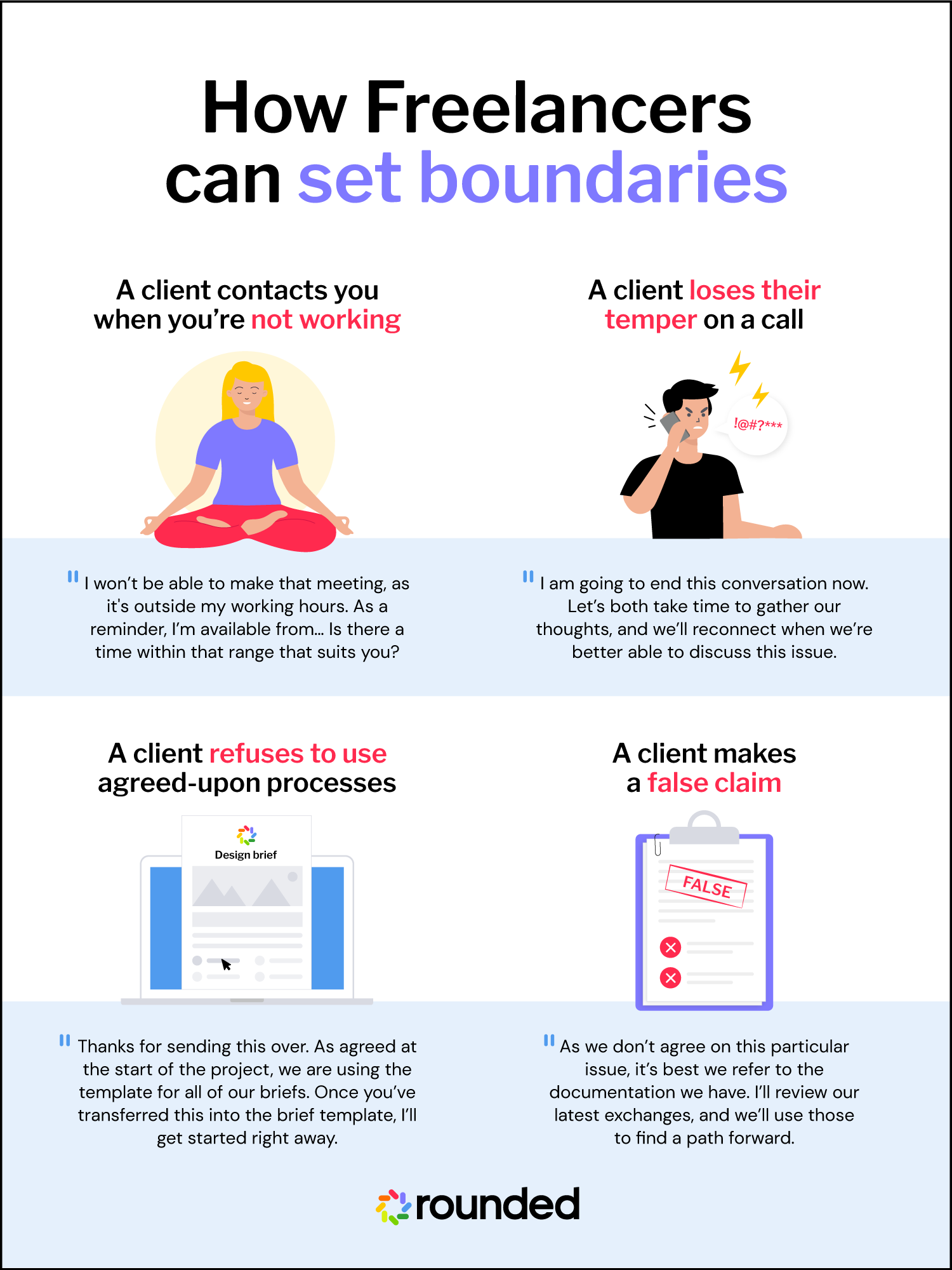
Use incentives to reward good client behaviour
Boundaries don’t have to only include negative consequences. You can encourage clients to adhere to your boundaries by offering positive incentives for good behaviour.
You could get people to pay invoices on time if you offer a 5% discount for early payment, Rebekah said. “Alternatively, you can reward clients who work well with you by providing them with testimonials and referrals, or even sending them small thank-you cards or gifts.
If you use this strategy, be sure to clearly tie your incentives to the boundaries you’ve set and the behaviour you’re rewarding. For example, if you want to reward a client who is always respectful of your time and insight, then say exactly that in a thank-you note at the end of a successful project.
How the freelance community is turning the tide on toxic behaviour
There’s one more thing you can do to improve client behaviour in the long-term, and it’s a mission shared by both Freelance Jungle and the team here at Rounded.
If we want to improve freelancer/client relationships long-term, we need to work together as a community to call out issues when we see them, set standards for positive behaviour, and support each other as we deal with the challenges that come with freelancing, Rebekah said.
This is what the recent Hug a Freelancer campaign was all about. Rounded and Freelance Jungle demonstrated both clients and freelancers are keen to improve communication and tackle the potential for discord for mutual benefit.
Be sure to join the Freelance Jungle Facebook group to keep up with future events for freelancers in Australia, and don’t forget to visit Rounded’s Freelancer Advice Library for more insights on how to manage the ins and outs of running your own business.
Cover Photo by Elisa Ventur on Unsplash
Join newsletter
ABOUT ROUNDED
Invoicing and accounting software for sole traders. Get paid faster and relax at tax time.
